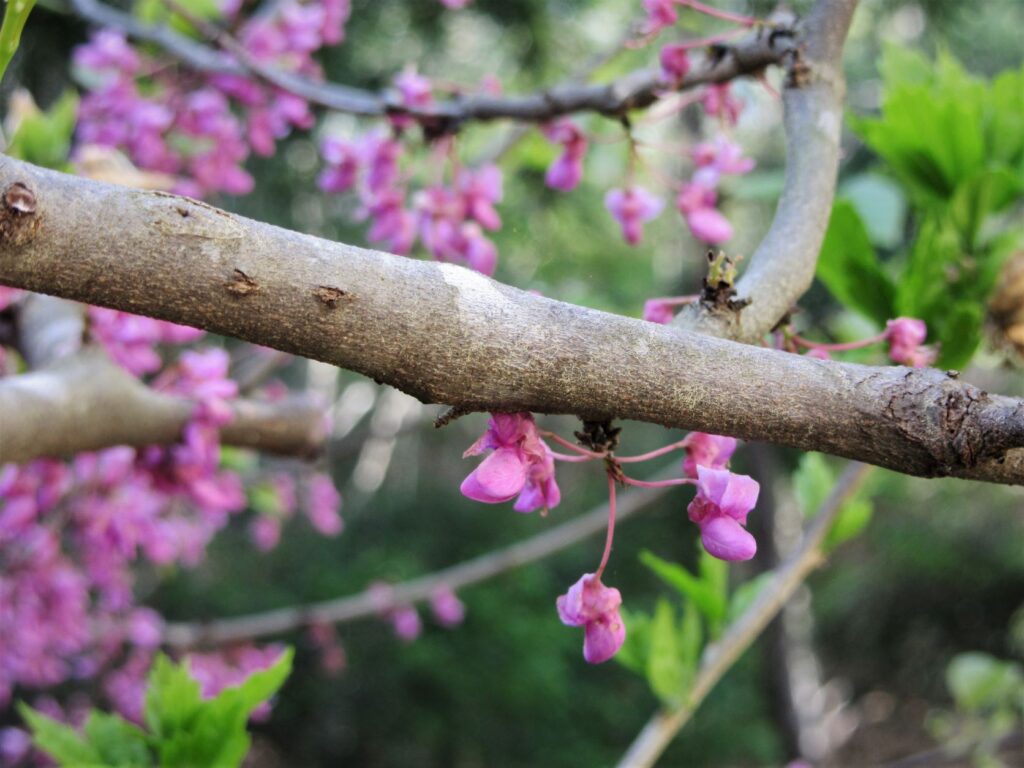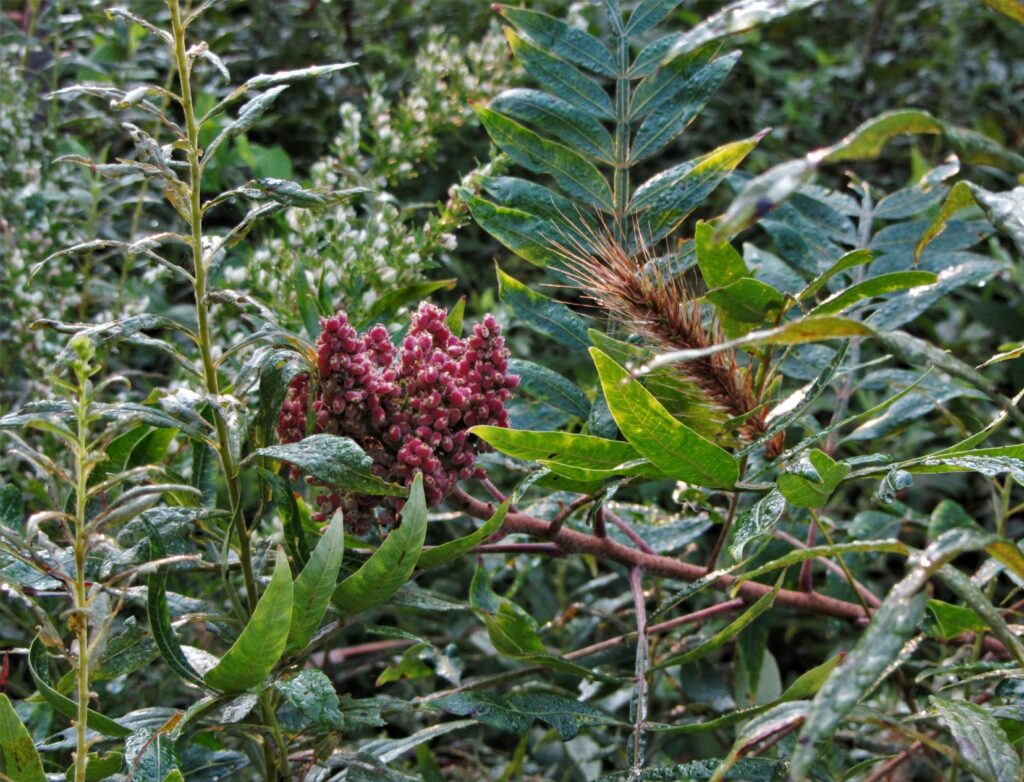Growing Indigenous Trees from Seeds
What Are Indigenous Trees?
Indigenous trees are those native species that have grown in our area since before European colonization. They are uniquely suited to our climate. They support our indigenous wildlife and make our landscape unique. Trees produced from long generations of the same species, that have all grown in our immediate area, are considered indigenous. A tree ordered from a mail-order nursery, even of the same species, was likely grown from seed, or a cutting, indigenous to another part of the country. It could be subtly different because its parent was adapted to another area.
North American trees were so highly valued in 17th and 18th Century Europe that a lively trade grew up between botanists in the ‘colonies’ willing to collect, package and ship seeds, and European plantsmen eager to receive those packages and grow out the seeds. North American trees were preferred for landscaping European parks and estates. Beautiful flowers, autumn color and graceful structure made them instantly popular. They added to the biodiversity of regions which had lost much of their forest in prior generations.
As Europeans favored North American trees, so we often value Asian trees and shrubs and gravitate towards showy, named woody cultivars so commonly found at local garden centers. Common native species that crop up in fields and on roadsides may not hold much appeal for us. And even if we want to grow an indigenous tree, they are difficult to buy.
Indigenous trees like our oaks, maples, pines, birches, hickories and cherries are keystone species, which each support hundreds of insect species. They are among the most useful native plants for sustaining our native butterflies and moths, along with many other types of insects important as a food source for our native birds. Native trees perform important work in maintaining our entire ecosystem. Most of our native insect larvae simply won’t feed on imported tree species, which means those important insects decline and eventually disappear.
Native trees feed pollinators when the trees bloom in late winter or early spring. This supports many species of birds, which require insects to feed their young. Later in the season, native trees produce a variety of seeds and nuts important for feeding birds and small mammals through the winter, when little other food may be available.
Collecting Seeds From Native Trees
Collecting seeds and growing indigenous trees provides a tremendous service to our community. Growing trees from seed takes time, but is a simple, enjoyable activity for gardeners who want to make a living contribution to the community.
September through December is the prime time to collect many fresh seeds. Pick up acorns, beech nuts, hickory nuts, buckeye seeds, seed pods from redbud trees, black locust pods, and opened cones with fresh pine seeds. Maple seeds ripen earlier in the summer. Seeds from woody plants respond well to soaking in hot water for several hours up to a day, depending on their freshness, before planting. This allows water to enter the tough seed coat and trigger metabolism. Consider soaking in a clean thermos bottle to keep the water hot longer.
When collecting acorns and other seeds, try to identify the parent tree. A photo of the tree in leaf will help you identify or confirm the particular tree species later. Label the container used while collecting. Once home, float each batch of seeds in a pan of water. Seeds that sink are viable, and those that float likely are not. Look for any small holes where insects may have burrowed inside, and discard these. If collecting a lot of seeds, it is useful to keep a log with details about each batch.
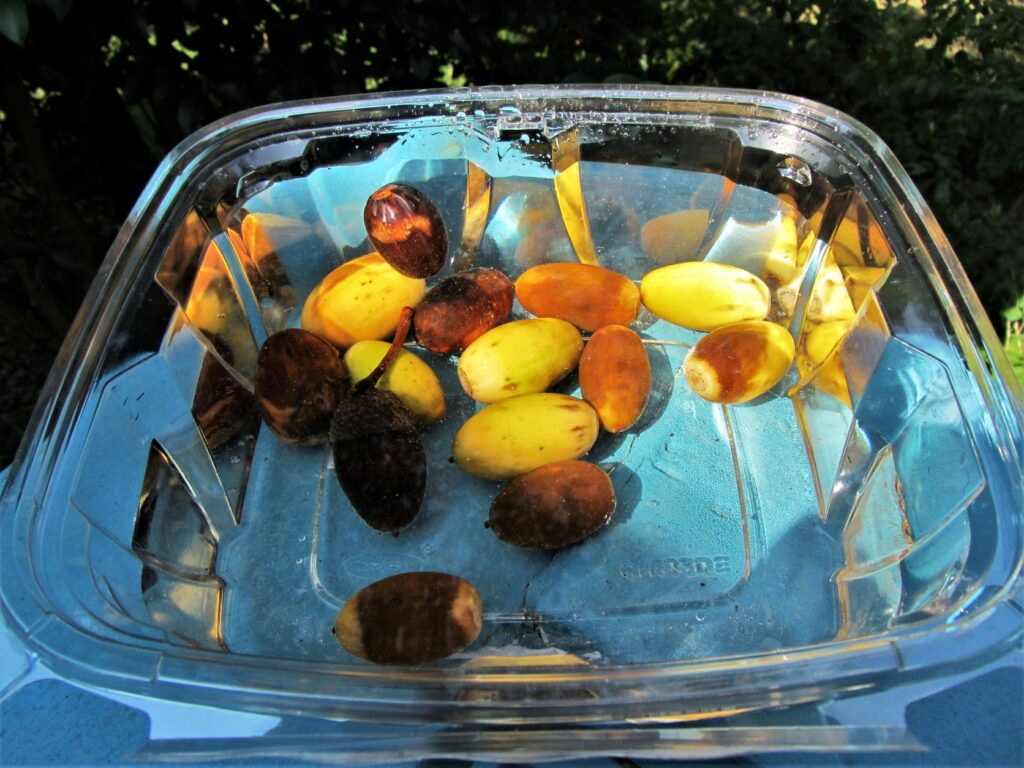
Soak newly collected acorns in hot water. Remove caps and inspect each acorn for any tiny holes made by an egg-laying insect. Seeds that float likely won’t sprout.
How to Sprout Tree Seeds
Seeds may be wrapped in damp paper towel and kept in a baggy until they sprout, or they may be ‘planted’ in a baggy filled no more than halfway with damp sand, peat based potting soil or damp vermiculite. Some seeds need light to germinate. Other seeds need an extended period of either warm or cold stratification to germinate. Ilex species grow best after passing through a bird’s digestive system, where the acids help prepare the seed coat. Some seeds are ready to grow when fresh.
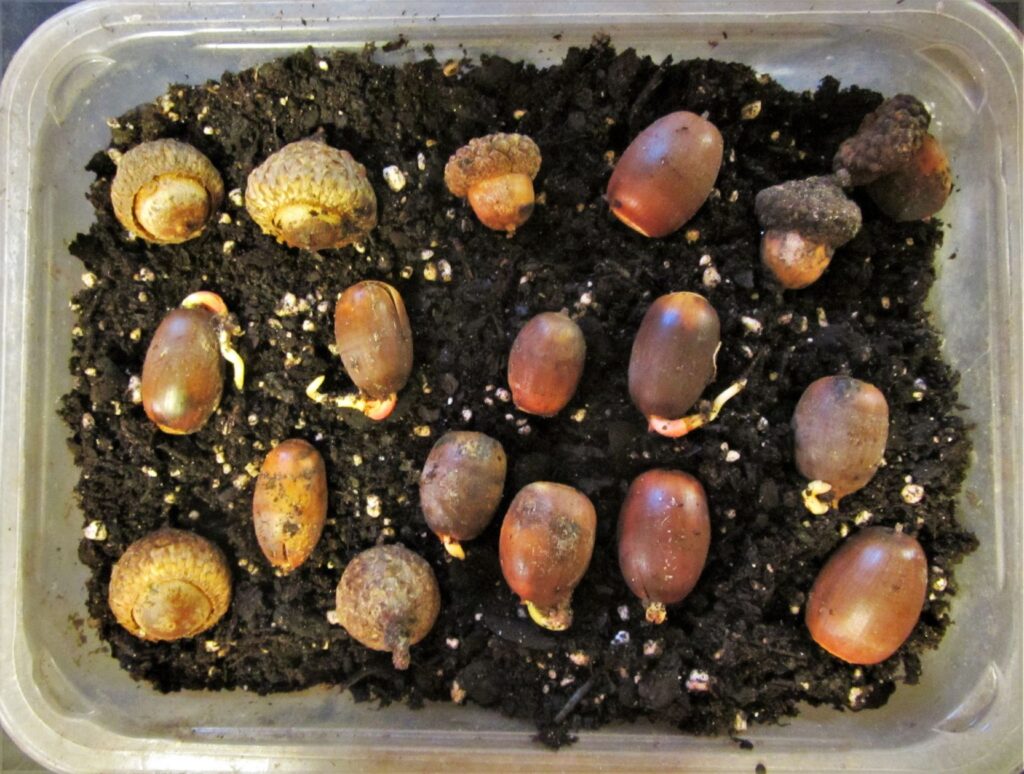
White oak acorns may begin to sprout on the ground after they fall. They develop roots during their first winter, and produce their first leaves the following spring. Acorns with stubborn caps my be too immature to grow. I covered these acorns with soil and sealed them in a zip lock bag to grow on, after taking the photo.
A little research on a particular species’ needs indicates whether heat, cold, or both is required for germination. Seeds requiring cold stratification may be kept outside over winter or placed in the produce drawer of your refrigerator for several weeks. Seeds needing warmth often respond well to a spot in the kitchen near a pilot light or a cabinet over the stove.

Castanea pumila, the Allegheny chinquapin, is indigenous to James City County. Collect the seeds and plant them as soon as the husk pops open in late fall. These are an important food for many animals.
Oaks, one of our most important keystone species, are some of the easiest trees to grow from seed. The seeds are easy to find and to collect, and ripe acorns can be found from September through early winter. Oaks species native to the South, like Quercus virginiana, may germinate immediately. Those native to northern regions, such as Quercus rubra, will likely need a period of cold stratification before germination.
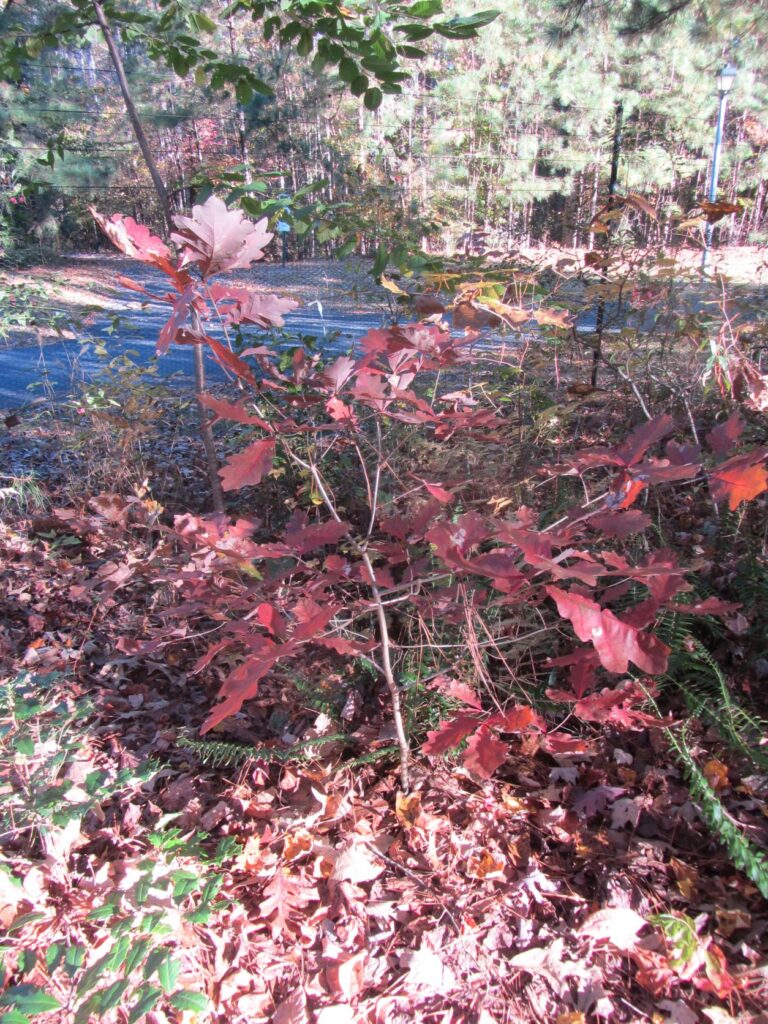
Acorns are such a highly prized food for birds and wild mammals that only a small percentage sprout and grow in the wild. When you find a seedling tree growing in a place where it can’t grow to maturity, consider carefully digging it and transplanting it sometime between autumn and early spring.
Sow collected tree seeds after soaking them in warm water for six hours or more. It is smart to dry them with a towel and spray them with an animal repellent such as Plantskydd, to protect them from squirrels and birds. If space isn’t a concern, each may be potted up in a 4”-6” pot, labeled, and then set aside in a protected area outdoors to sprout. Otherwise, wrap the viable seeds in moist paper towels, or mix with planting medium, and seal in a labeled plastic box or bag.
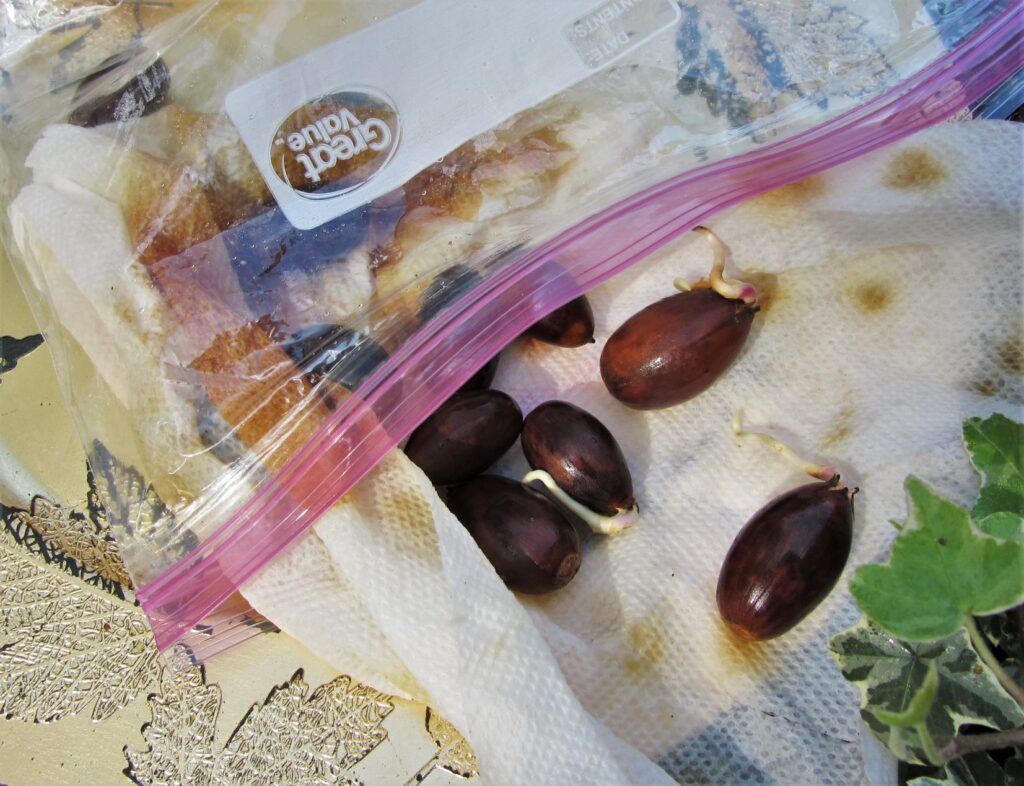
A variety of woody seeds will sprout wrapped in damp paper towels and sealed in a bag. Use this method for chestnuts, hickories, maples, buckeyes, apple or avocado seeds, citrus seeds, and many other types of large seeds. Watch for signs of growth every few weeks, and plant seeds into pots with soil after they sprout.
Potting Up Tree Seedlings
Seeds started in a baggy may be planted into pots once they have cracked open and the radicle, or embryonic root, has appeared. To plant the germinated seeds, fill a 6″ plastic nursery pot with a soil mix blended to support trees. Mix up an appropriate potting mix from fine pine bark mulch, compost, soaked peat, with some builder’s sand or perlite added to improve drainage. Let 2 parts be bark mulch, 1 part compost or peat and 1 part sand or perlite. If using a commercial potting soil, mix it with an equal amount of bark mulch. After planting the seed, label and mulch each pot with about ¼” of chicken grit, vermiculite, or fine aquarium gravel.
Protect newly planted seeds from squirrels by placing the pots on a screened porch, in a cold frame, or in a container, such as a clear plastic box with a lid. Check the seeds regularly to make sure the soil is moist. Once new growth is visible, allow the plants to grow on in a partially shaded spot. I have lost many young trees to squirrels at this stage. Use Plantskydd, Milorganite, or some other animal repellent to protect seedling trees.
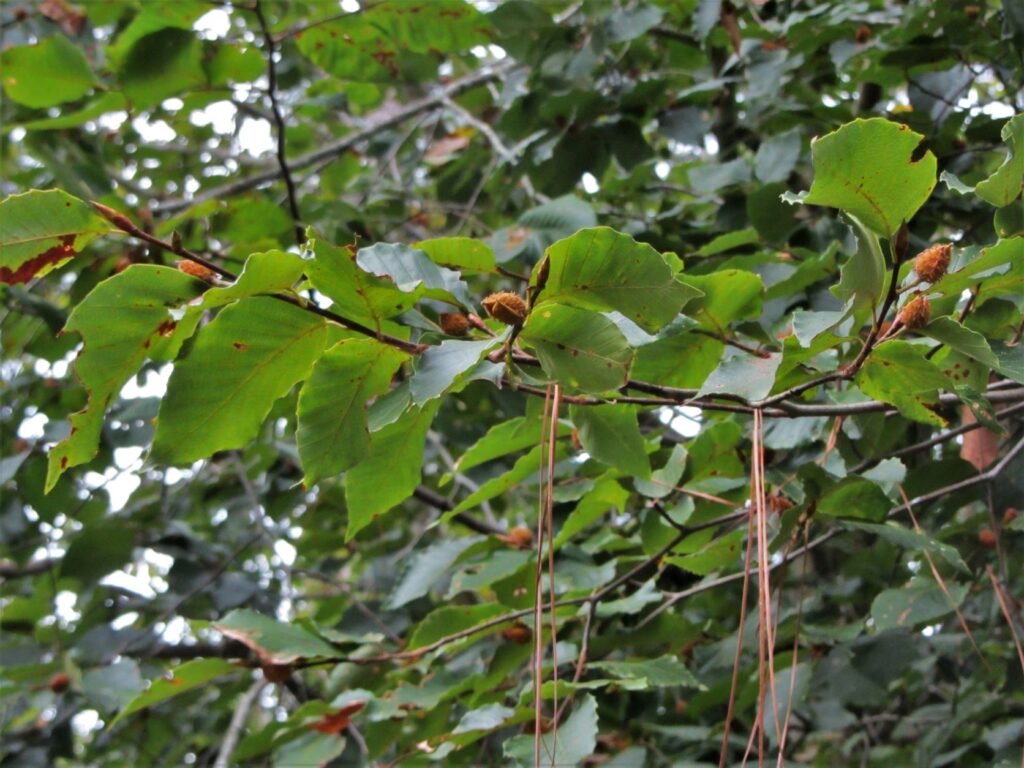
Collect and sow Fagus grandifolia, American beech, seeds when they are fresh, as soon as their shells crack open.
Expect to grow your baby trees for some time so they are well- established before they are transplanted. Once growing, move the seedlings up to a deep enough pot for roots to develop without circling the pot. Take care not to damage the main tap root. A 1-3 gallon pot is a good start, depending on how each species’ roots grow. Plant trees into their permanent spot when they are two to three years old. They will still need protection from nibbling deer during their early years of growth.
How to Share Native Trees With the Wider Community
You can offer your native tree seedlings to neighbors or friends, donate them to our next Master Gardener plant sale, or donate them to the Honor Box plant sale at the Williamsburg Botanical Garden and Freedom Park Arboretum. However we get them into the community, we can use them to teach the larger community to value our native, indigenous trees, and make them available as an alternative to the mass produced trees so commonly available at local retail nurseries.
All Photos by E. L. McCoy
For more information:
Bubel, Nancy. The New Seed-Starter’s Handbook. Rodale Press. Emmaus PA. 1988.
Copp, Catherine. Mighty Oaks from Little Acorns: The Complete Guide to Growing Oak Trees From Seed. CreateSpace Independent Publishing Platform. 2017.
Dirr, Michael A. and Charles W. Heuser, Jr. The Reference Manual of Woody Plant Propagation from Seed to Tissue Cultures. Varsity Press, Inc. Cary, NC. 2006.
Druse, Ken. Making More Plants: The Science, Art, and Joy of Propagation. Clarkson Potter/Publishers. New York, NY. 2000.
Smith, Miranda. The Plant Propagator’s Bible: A Step-by-Step Guide to Propagating Every Plant in Your Garden. Cool Springs Press. 2021.
Wulf, Andrea. The Brother Gardeners: Botany, Empire, and the Birth of an Obsession. Knopf Doubleday Publishing Group. New York, NY. 2019.




